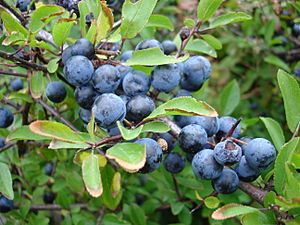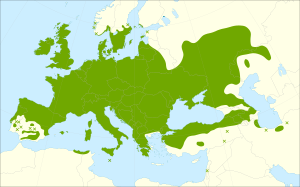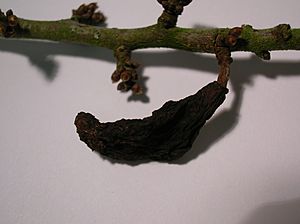Blackthorn facts for kids
Quick facts for kids Blackthorn |
|
|---|---|
 |
|
| Fruit | |
| Conservation status | |
| Scientific classification | |
| Genus: |
Prunus
|
| Species: |
spinosa
|
 |
|
| Distribution map | |
The blackthorn or sloe (scientific name: Prunus spinosa) is a type of flowering plant that belongs to the rose family. It grows naturally in Europe, western Asia, and parts of northwest Africa. You can also find it growing in places like New Zealand, Tasmania, and some areas of the United States.
The fruits of the blackthorn are called "sloes." People use them to make special drinks like sloe gin in Britain and patxaran in the Basque Country. The strong wood from the blackthorn is also used to make walking sticks, including the famous Irish shillelagh.
Contents
What is Blackthorn?
The blackthorn is a large deciduous shrub or a small tree. This means it loses its leaves in autumn. It can grow up to about 5 meters (16 feet) tall. It has dark, almost black bark and many stiff, spiny branches.
Its leaves are oval-shaped, usually 2 to 4.5 centimeters (about 1 to 1.7 inches) long. They have a jagged edge. The flowers are small, about 1.5 centimeters (0.6 inches) wide, with five creamy-white petals. They appear in early spring, even before the leaves grow. These flowers have both male and female parts and are pollinated by insects.
The fruit is a round, dark berry called a "sloe." It's about 10 to 12 millimeters (0.4 to 0.5 inches) across. Sloes are black with a purple-blue waxy coating. They ripen in autumn, usually in October or November, after the first frosts. Fresh sloes have a very strong, sour taste.
Blackthorn usually grows as a bush, but it can become a tree up to 6 meters (20 feet) tall. Its branches often grow in a tangled way.
Blackthorn vs. Cherry Plum
Sometimes, people confuse blackthorn with a similar plant called the cherry plum (Prunus cerasifera). This often happens in early spring when both plants are flowering.
Here's how to tell them apart:
- Blackthorn flowers are pure white, while cherry plum flowers are creamy white.
- The sepals (small leaf-like parts under the flower) bend backward on a cherry plum but not on a blackthorn.
- In winter, blackthorn bushes look bushier with stiffer, wider branches.
- In summer, blackthorn leaves are narrower, more than twice as long as they are wide.
- In autumn, blackthorn fruits are purplish-black. Cherry plum fruits are yellow or red.
Where Does Blackthorn Grow?
Blackthorn is native to Europe, western Asia, and some parts of northwest Africa. It has also started growing naturally in places like Tasmania (Australia) and eastern North America.
Animals and Blackthorn
Many insect larvae, especially caterpillars of Lepidoptera (moths and butterflies), eat the leaves of the blackthorn. Some examples include the small eggar moth and the emperor moth. The dead wood of blackthorn also provides food for some caterpillars.
Uses of Blackthorn
Because blackthorn has long, sharp thorns, it has been used for centuries to make strong, cattle-proof hedges in Britain and other parts of northern Europe.
The sloe fruit is similar to a small damson or plum. It's good for making preserves like jam. However, it's very sour and tart to eat fresh, unless it's picked after the first few days of autumn frost. Freezing harvested sloes can have a similar effect, making them less tart.
Blackthorn is a tough plant that can grow in many different conditions. Because of this, it's often used as a rootstock for other types of plum trees and some other fruit trees. This means the roots and lower part of a blackthorn plant are used to grow another type of fruit tree on top.
Sloe Drinks
The juice from sloes is used to make a popular British drink called sloe gin. This is made by soaking sloes and sugar in gin. You can also make a similar drink by using vodka instead of gin. In northern Greece, people make a blackthorn liqueur by soaking the fruit in a spirit called tsipouro with sugar.
In Navarre, Spain, a well-known liqueur called pacharán is made from sloes. In France, a drink called épine or troussepinette is made from the young shoots of the blackthorn in spring, rather than the fruits. In Italy, a liqueur called bargnolino is made by soaking the fruits in alcohol with sugar. Wine made from fermented sloes is also produced in Britain, Germany, and other central European countries.
Sloe Food
Sloes can be made into jam, chutney, and used in fruit pies. Sloes preserved in vinegar taste similar to Japanese umeboshi. The juice of the fruits can also be used to dye fabric a reddish color that turns into a durable pale blue when washed.
Historically, the leaves of the blackthorn were sometimes used as a substitute for tea leaves.
Archaeologists have found blackthorn fruit stones in ancient human settlements. This shows that people have been eating sloes for a very long time. For example, a sloe was found near the 5,300-year-old human mummy known as Ötzi, suggesting he intended to eat it before he died.
Blackthorn Wood
Blackthorn wood is excellent for burning because it burns slowly, gives off good heat, and produces little smoke. The wood can also be polished to a smooth finish and is used for tool handles and canes. Straight blackthorn stems have traditionally been made into walking sticks or clubs, like the famous shillelagh from Ireland. In the British Army, officers of the Royal Irish Regiment carry blackthorn sticks as part of their tradition.
Blackthorn in Culture
In old English, the word slō was sometimes used to describe something that wasn't very important.
The phrase "sloe-eyed," which means having dark eyes, comes from the dark color of the sloe fruit. This phrase was first used in a novel in 1867.
The flowering of the blackthorn might have been connected to the ancient Celtic celebration of Imbolc. This holiday was traditionally celebrated on February 1st in Ireland, Scotland, and the Isle of Man.
The name of a dark-colored fabric called prunella came from the French word prunelle, which means sloe.
Images for kids
-
Blackthorn shrub in the Vogelsberg
-
(Presumably grafted) Husband and wife tree
Related pages
- Senegalia mellifera, a common thorn tree in Africa.
See also
 In Spanish: Endrino para niños
In Spanish: Endrino para niños









